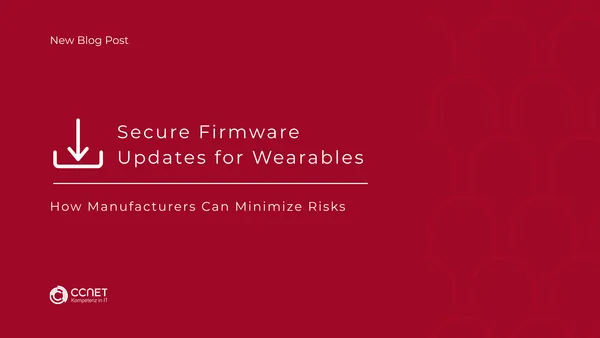
CCNet
Aug 13, 2025 • 2 min read

Secure Firmware Updates for Wearables: How Manufactures can minimize risks
Firmware updates are essential for closing security gaps, delivering new features, and extending the lifespan of wearables. However, poorly secured update mechanisms can themselves become vulnerabilities, allowing attackers to inject malicious software onto devices. To minimize these risks, manufacturers must implement secure update procedures. This article outlines how firmware updates for wearables can be made secure.
1. Why Are Secure Firmware Updates Important?
Wearables are increasingly connected to the internet, smartphones, and cloud services. Any firmware vulnerability can be exploited to compromise sensitive user data or hijack the device for cyberattacks. Unencrypted or unsigned updates offer attackers a chance to install malicious software and take control of the device. A secure update mechanism is therefore critical to long-term user safety.
2. Key Security Risks in Firmware Updates
Insecure firmware update processes can lead to the following risks:
- Tampering by third parties: Insecure update channels allow attackers to inject malware into the update process.
- Man-in-the-middle attacks: Without encrypted communication between the device and the update server, attackers can alter files or distribute fake updates.
- Unsigned updates: If no digital signature is used, modified firmware can be installed by users or attackers—posing serious risks to device integrity.
- Lack of rollback mechanisms: If an update fails or contains corrupted files, the device can become unusable without a safe fallback mechanism.
3. Best Practices for Secure Firmware Updates
To secure the update process, manufacturers should adopt the following practices:
a) Use Digital Signatures and Certificates
Every firmware update should be cryptographically signed, ensuring that only updates from verified sources are accepted. Digital signatures confirm that the update has not been tampered with and originates from a trusted vendor.
b) End-to-End Encryption
All update-related communications must be encrypted to prevent man-in-the-middle attacks. This can be achieved by using TLS (Transport Layer Security) and encrypted download channels.
c) Secure Update Servers
The servers distributing firmware updates must be highly protected. This includes access control mechanisms, regular audits, and defenses against DDoS attacks.
d) OTA (Over-the-Air) Updates with Failover Mechanism
Wearables should receive updates wirelessly and automatically, without requiring users to engage in insecure installation steps. If an update fails, the system should support a secure rollback mechanism to revert to a previous version.
e) Transparent Update Policy for Users
Users must be informed about the update process and its implications. Automatic updates should be clearly labeled, and changelogs should be publicly available. This creates trust and ensures compliance with data protection regulations.
4. Conclusion: Firmware Updates as a Critical Security Factor
Firmware updates are not just about feature enhancements—they are central to the security of wearable devices. Manufacturers must take the update process seriously and implement robust, encrypted, and verifiable systems. Only then can wearables remain secure over the long term and protect sensitive health data.


